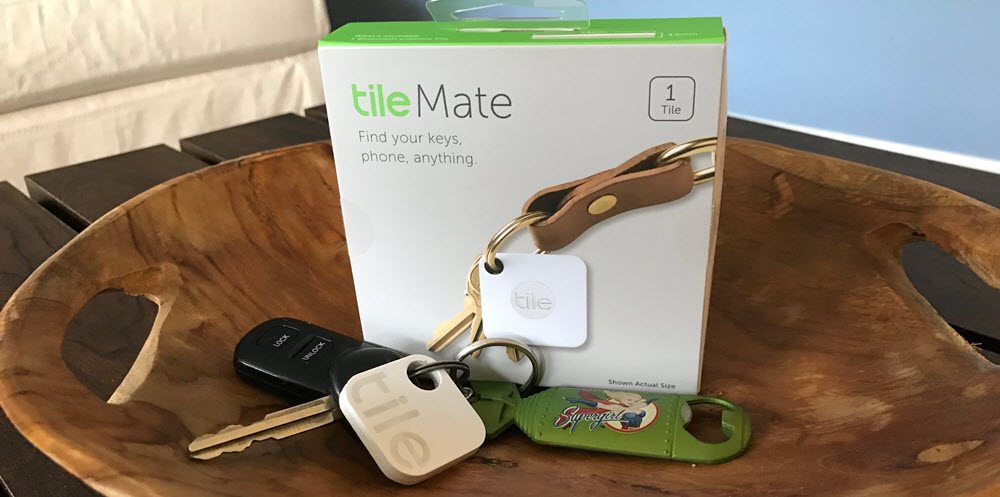 Some people love real-time games, and some people find them too stressful. Personally, I love heavy strategy games but I love taking a break for some silliness, too. Gobbit and Angry Birds Gobbit are two flavors of a fast-paced card-slapping game that I brought home from Gen Con this year.
Some people love real-time games, and some people find them too stressful. Personally, I love heavy strategy games but I love taking a break for some silliness, too. Gobbit and Angry Birds Gobbit are two flavors of a fast-paced card-slapping game that I brought home from Gen Con this year.
At a glance: Gobbit and Angry Birds Gobbit are quick reaction card games, for 2* to 8 players, ages 10 and up, and take up to 10 minutes to play (though many games end even sooner). Gobbit retails for $18 and Angry Birds Gobbit retails for $22—so far the only place I’ve seen them online in the US is Cool Stuff Inc., and they should also be making their way to game stores in the US. (They are more widely available in Europe.) It’s published by Old Chap Editions and distributed by Morning Players.
* Regular Gobbit requires at least 3 players, and Angry Birds Gobbit has an option for 2-player duels.
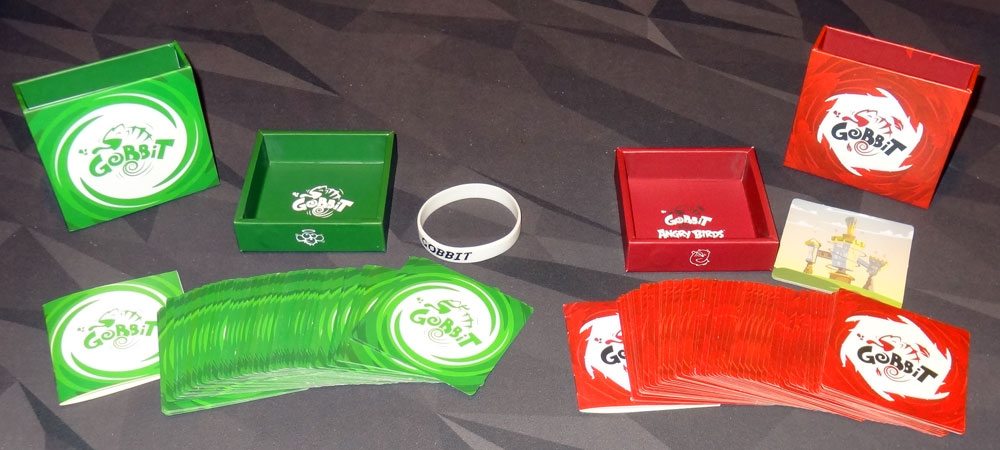
Components
Both versions have very similar components: 54 cards in a magnetic storage box. The original version also includes a rubber wristband (more on that later), and the Angry Birds version also includes a Castle tile, the same size as the cards but cardboard instead of cardstock.
The cards are square, about the size of a coaster, and have great illustrations on them. Original Gobbit has flies, chameleons, cobras, and gorillas. Angry Birds Gobbit has three of the birds (Red, Chuck, and Bomb), pigs, and eggs, plus one “enraged” version of each bird.
The packaging is worth noting, because (as you know) I’m always complaining about box sizes—it’s hard to design for both retail and the end user, because those are often working at cross-purposes. In this case, the game comes in a retail package, sort of a tuckbox with a window and a plastic insert: that package has a little more info about the game and is sized to look nice on a shelf (though it’s still not huge). I actually ditched this outer box when packing up after Gen Con, so I only had to bring home the small interior box.

Inside, there’s a smaller box that basically holds the cards exactly. Unlike the outer box, which is thin cardstock, the interior box is sturdy cardboard, sort of a slipcover-style drawer, and a magnet holds it in place. There’s a small window at one end that shows a graphic when you have the drawer oriented the right way, and you can use it to push the drawer out. The interior box doesn’t have all the game info on it, just the cover graphic, and it looks really slick (though I do wish it had the number of players printed on it somewhere). Granted, this sort of packaging does mean more waste: you’ve got some extra cardboard and plastic to recycle. On the other hand, I don’t have to live with a box that’s 50% air, taking up extra space on my game shelves and when I want to take the game on the go.
The wristband is one of those rubber bracelets—it’s white and says Gobbit on it. The idea is that (at least in Europe for now), there are duel events where players can earn other colors, like karate belts. If you have your bracelet and you encounter somebody who is one rank higher than you, you may challenge them to a game of Gobbit and they must accept. If you win, you swap wristbands.
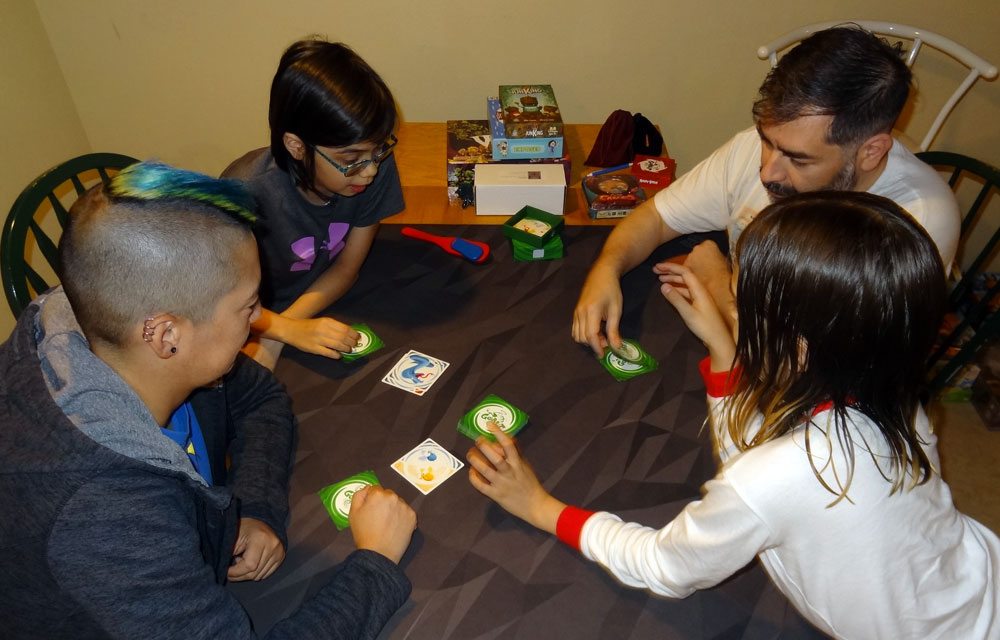
How to Play
The goal of Gobbit is to be the last player with cards remaining—you have to slap other players’ stacks at the right time to steal them, or slap your own stack to prevent it from being stolen. The two have slightly different rulesets, so I’ll explain the original first, and then the Angry Birds version.
Original Gobbit
Most of the cards show snakes, chameleons, and flies, and they appear in red, blue, or yellow. The flies cards show two flies, which are sometimes both the same color and sometimes two different colors. The two-color flies and gorillas can be removed the first time you play.

Deal out all of the cards evenly: each player gets a pile. Players take turns flipping over the top card of their piles into a stack in front of them (each player has their own stack). Any time a food chain combination appears, the players involved must slap quickly: snakes eat chameleons, and chameleons eat flies—but only if the colors match. If you can eat somebody, or somebody else can eat you, you slap the stack that can be attacked—whoever is fastest gets to take the stack and put it underneath their pile.
If you ever slap incorrectly—you weren’t actually involved in the conflict, or you slapped the attacker, or you tried to eat something of the wrong color—then that’s a foul, and your stack goes face-down in the center of the table, in the “graveyard.”
That’s the basic game: you just play until all players but one have run out of cards, and that player is the winner.

But then there are some additional rules you can throw in.
First, the “Gobbit!” If at any time there are all three colors of flies showing, everyone can race to call “Gobbit!” and slap the graveyard. The first player to do so collects their own stack and another stack of their choice. Everyone else just gets their own stack. Then play restarts.
Next, Poltergeist: If you run out of cards, you’re not out of the game yet. You can’t win, but you can mess with other players. Any time an exact pair is showing, poltergeists can attack both stacks. Any stack that isn’t defended gets put into the graveyard.
Finally, the gorillas: they just attack everything. If you flip a gorilla, you can attack everyone else and they have to try to defend themselves. Anything that gets attacked goes into the graveyard. The gorilla player then plays another card to continue play.

There are also an expert mode, when you’re ready for the next level. There are actually seven different versions of the card backs. During expert mode, you have to take the top card of the graveyard into consideration.
- Default: Play as usual.
- Blindfold: Color rules don’t apply.
- Poltergeist: All players may attack pairs as if they were poltergeists.
- Reverse: The order of the food chain is reversed.
- Snakes eat flies: Snakes and chameleons can attack flies.
- Rainbow: You can only attack something of a different color.
- Exploding flies: Hitting flies counts as a foul.
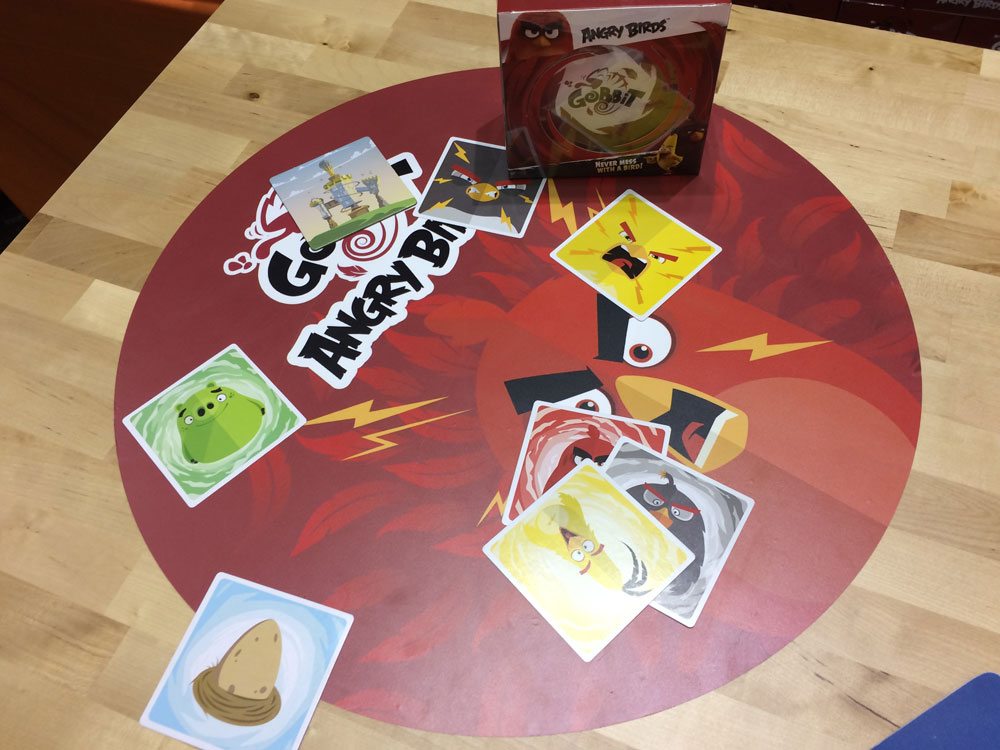
Angry Birds Gobbit
In this version, the cards are three colors of birds, a pig, and an egg. There’s also an enraged version of each bird.
Setup is the same, but with the Castle tile in the middle. The first time you play, take out the three enraged bird cards.
The basic gameplay is also the same: when certain matches occur, you slap to attack or defend, and if you’re successful, you get to collect your stack and put it back under your pile. In this case, it takes two of the same thing to attack one of the other: specifically, two of the same bird can attack a pig, or two pigs can attack a bird. So any time there’s a conflict, there are at least two potential attackers and one defender. The egg card can be attacked by anyone, regardless of what else is on the table.
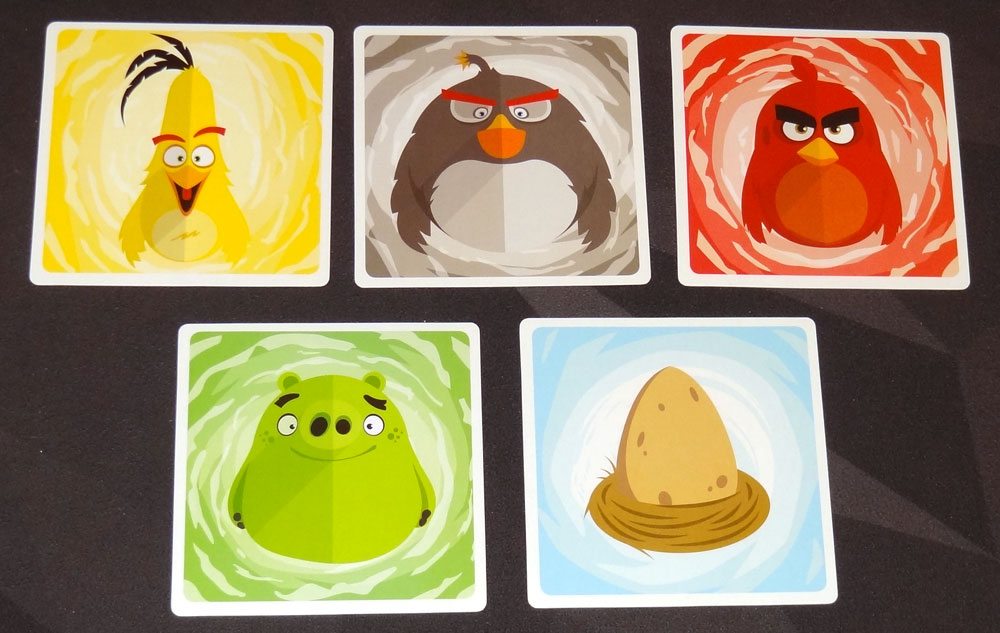
Any time there’s a foul (an incorrect slap), that player puts their stack on the Castle—these cards are now jailed.
When there are only two players remaining (or in a two-player-only game), you switch to duel rules: the jailed cards are turned face-up to the side, and the top card of the jailed cards now acts as a dummy third player. Now, discarded cards go on top of the jailed cards, changing the face-up card. (At the start of a 2-player game, you would simply place one card face-up in the jail at the beginning of the game.)
There’s also a “Gobbit” rule in this game: if all three different birds are ever visible at the same time, players must call “Gobbit” and slap the Castle stack—the winner gets to collect their own stack and one other player’s stack. All other players collect their own stacks.
The Poltergeist rule is slightly different: players who are out of cards may slap any stack if it has two consecutive cards that are the same. If a poltergeist successfully slaps your cards, they go in the jailed cards.

Finally, there’s Angry Mode. Add in the enraged bird cards. When you draw one, it’s like the gorilla: you get to slap any stack that isn’t the same bird. (So if you have angry Chuck, you don’t get to slap a regular Chuck.) Any stacks that aren’t defended go to the jail.
The Verdict
Like I said at the beginning of the post, I often have a preference for games that involve strategy and a lot of thinking—the sort of games in which much of the game involves the players sitting around quietly contemplating the board. But not all the time. Sometimes it’s great to cut loose with a game that just makes people loud and raucous, and Gobbit is one of those games. It reminds me a little bit of Snorta! and Anomia, two other quick-reaction games, because of the way that everyone has a stack of cards and starts flipping them over, looking for a match. In this case, however, the reaction is slapping rather than shouting (or making animal noises).
The original Gobbit has a lot of flexibility—you can make it very basic by taking out the two-color flies and the gorillas, and playing just by the very basic food chain rules. Or you can introduce a couple rules at a time. And then there’s the expert mode, to just mix everything up a bit. You’ll get a lot of mileage out of it because of those variants.
The Angry Birds Gobbit is not just a simple retheme but actually changes up the gameplay, because of the way you have to have two of something to attack something else—it’s similar enough that it’s easy to teach, but is also different enough to be its own game. Plus, of course, those Angry Birds have the brand recognition for a lot of kids and adults.
I don’t know how well the wristband idea will work in the US—depends on whether Morning Players will have the same sorts of events here as they apparently have in France and the rest of Europe, because if all anyone has is a white bracelet, then there’s never anyone to challenge. I’ll be curious to see how that is handled.
I already said it once, but I really do like the boxes—these two small boxes don’t take up much space on my shelf or in my bag, and the magnet to hold the box together is a very nice touch that just adds that extra bit of “wow” factor to a slick-looking game.
I’d recommend either flavor of Gobbit (or both!) to fans of games like Spot It!: it’s a great filler game that you can take on the go, plays quickly (and a wide range of player counts), and will likely draw a crowd whenever you play. And since it’s so short, you can invite that crowd to jump in for the next game.
Disclosure: I received review copies of these games.


